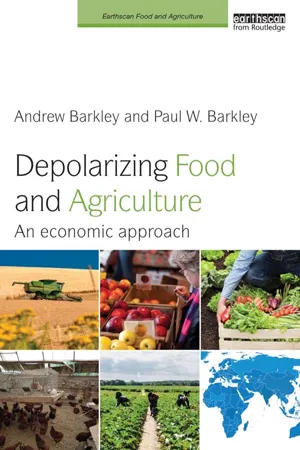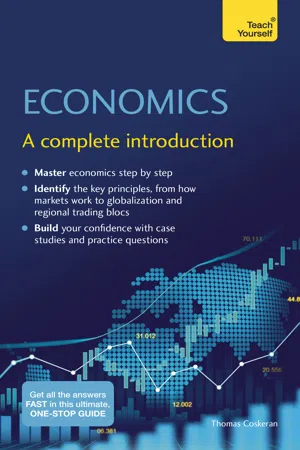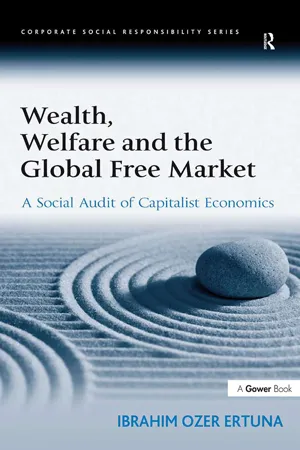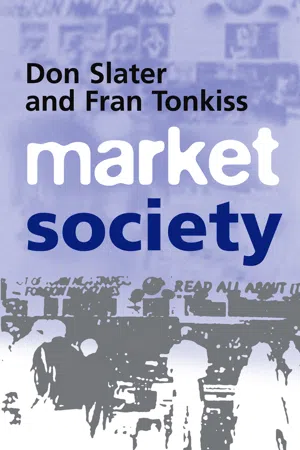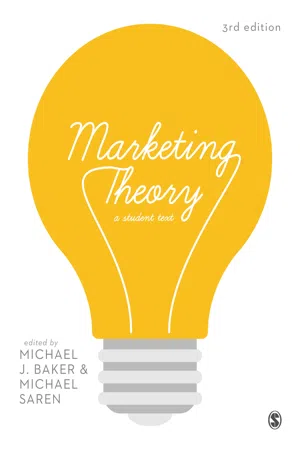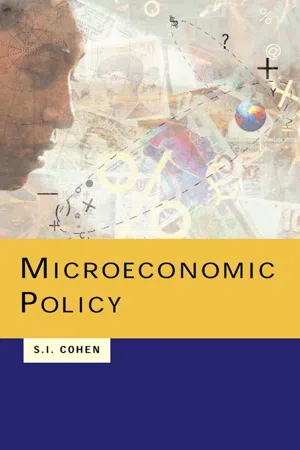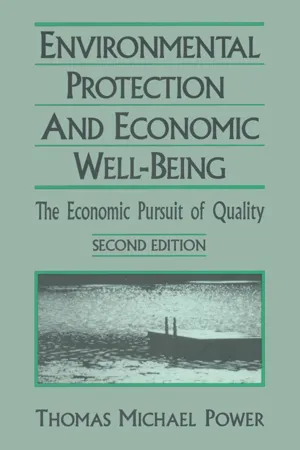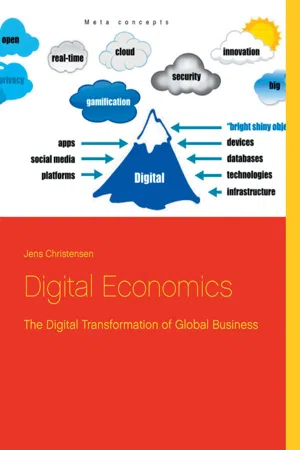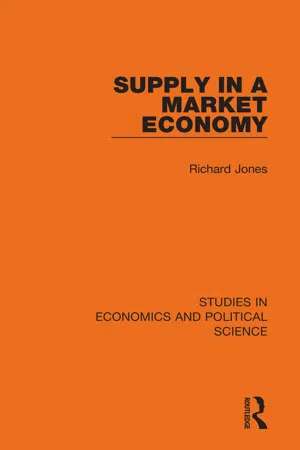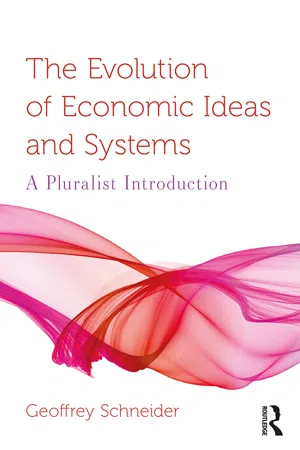Economics
Market Economy
A market economy is an economic system in which the production and distribution of goods and services are determined by the interactions of supply and demand in the marketplace, with minimal government intervention. Prices are set by the forces of supply and demand, and resources are allocated based on consumer preferences and business decisions.
Written by Perlego with AI-assistance
Related key terms
11 Key excerpts on "Market Economy"
- eBook - ePub
Depolarizing Food and Agriculture
An Economic Approach
- Andrew Barkley, Paul W. Barkley(Authors)
- 2014(Publication Date)
- Routledge(Publisher)
Today’s industrial agriculture has followed a similar path by adding inputs such as chemicals, fertilizer, and machinery. These inputs to food production are generally produced by large corporations and sold to farmers and ranchers who, in turn, provide raw foods to processors, often large food corporations such as Kraft, ConAgra, or Beatrice. Retailers and distributors complete the circular flow through specialized and concentrated supermarket chains: Kroger, Safeway, and Walmart, who sell daily food needs to consumers. Different nations and different cultures organize their economy in different ways. We will explore these differences in the next section.Market economies, command economies, and mixed economiesA “Market Economy” is an economy characterized by market interactions where resources and goods are allocated by prices. In contrast, a “command economy” is defined as an economy characterized by command and control, in which resources are allocated by whoever is in charge, whether it be a dictator, or a committee of appointed experts, or democratically elected officials. The characteristics of each of these two extreme cases of economic organization are explored below. In reality, the two polar cases are hypothetical, since market-based economies have high levels of government involvement, and command economies have many features of market systems. Thus, as a practical matter, all real-world economic systems are “mixed economies,” that combine features of markets and government regulation and services. Large potential societal gains come from markets (high incomes and economic growth), as do costs of disruption, change, and income inequality (Piketty and Goldhammer, 2014). The benefits of markets come at a cost, and the costs lead to polarization of views and opinions on political and economic issues. The weaknesses and limitations of markets are presented and evaluated in later chapters of the book.Market economies and consumer sovereignty“Consumer sovereignty” is the foundation of market systems since consumer preferences determine the production of goods and services. The firms that do the best job of providing what consumers desire will be the most successful. Producers, firms, and distribution networks all respond to consumer wants and desires. Moreover, in a Market Economy, producers’ activities must remain consistent with consumer demands (or desires), or firms will face going out of business. It is often argued that big firms such as Microsoft, Walmart, and McDonald’s are bad for the economy and bad for consumers. In many ways, this is not the case in a competitive Market Economy with many choices of where to shop. The firms that earn the largest revenues from product sales provide evidence that consumers desire products from these large producers and sellers. While it is true that organizational and administrative problems may exist within each of these huge firms, just as they exist in firms of all sizes, it remains true that the firms must be doing something right, or they would not sell so much software, groceries and household goods, hamburgers, fries, and other products. In many cases, the most profitable firms are the ones that are most successful at dealing with market changes. - Thomas Coskeran(Author)
- 2012(Publication Date)
- Teach Yourself(Publisher)
Like many of humanity’s best ideas, the invention of markets is not attributed to any individual or group of individuals. Its origins are lost in the fog of history. While economists did not invent the market system, it has fallen to them to analyse it and explain how it works. This chapter outlines some of their conclusions.Spotlight: What’s in a name?
The Market Economy goes under various guises: the market mechanism, the price mechanism, the market system, the free enterprise system, laissez-faire and capitalism. But they all refer to a system that is supposed to produce the best for society by allowing individuals to pursue their own, often selfish, interests.Properties of the market
Economists think markets have the following features:▸ Consumers want to buy (or ‘demand ’) goods and services from producers who are prepared to produce (or ‘supply ’) them.▸ Both consumers and producers pursue their self-interest (they are all ‘economic man’).▸ Goods and services have prices usually denominated in money.▸ Demand and supply determine prices.▸ Prices inform everyone how scarce goods and services are. The lower the good’s price, the more abundant it is; the higher the price, the scarcer it is. That is a lot of information.Key idea: Market locations
Markets occur where consumers and producers interact with each other. It might be, but does not have to be, a physical location. Markets form on the telephone and the internet and through mail order.The importance of market prices has caused economists to think carefully about them, a process that has led them to conclude that prices depend upon the forces of supply and demand. In considering how markets work, we analyse each of these forces separately before combining them to show how prices result. We examine first the nature of demand.The existence of a free market does not of course eliminate the need for government. On the contrary, government is essential both as a forum for determining the ‘rule of the game’ and as an umpire to interpret and enforce the rules decided on.- eBook - ePub
Wealth, Welfare and the Global Free Market
A Social Audit of Capitalist Economics
- Ibrahim Ozer Ertuna(Author)
- 2016(Publication Date)
- Gower(Publisher)
It is interesting that the discrepancy between the promise and the reality did not have any significant effect on the belief in the virtues of the capitalist religion. Since capitalism has converted itself into a religion this is interesting, but not surprising. Still today the belief persists that the prices determined in free markets, in a competitive environment, will be able to guide economies to provide the best solutions to the economic problems of humanity. This belief is expanding and getting stronger.Markets and Prices
Market economies are guided by prices determined in the markets. As we noted above, classical economics defines four different markets in the market economies: goods and services markets, foreign exchange markets, capital markets, and labor markets. In each market, prices develop under the rule of supply and demand. These prices respectively are prices of goods and services, foreign exchange rates, interest rates, and wages. These prices, as determined in their respective markets, guide the economy in free market economies. The decisions on the allocation of income to consumption and savings, allocation of consumption to different products and services, what will be produced in what amount, how much will be invested in machinery and equipment and human capital, how much money will be raised to make the investments and to finance the customer: all these decisions are guided by the prices determined in the markets. Now let us turn to each one of the markets to observe the assumptions and conclusions of the theory.Goods and Services Markets
Economic theory is built under the assumption that both supply and demand are under the influence of prices. It is assumed that more would be demanded at lower prices, less would be demanded at higher prices. On the other hand, at higher prices more would be supplied, while less would be supplied at lower prices. Similarly, when the prices increased, more would be supplied but less would be demanded; and when the prices decreased more would be demanded but less would be supplied. As it is seen, as the prices increase or decrease, the supply and demand are affected in opposite directions. This, then, guarantees that there would be an equilibrium price. This is called the demand and supply rule. Under the demand and supply rule, the equilibrium price clears the market. That is, there would be no seller in the market who is willing to sell but cannot at the equilibrium price; and, there would be no buyer in the market who is willing to buy but cannot at the same equilibrium price. This is the indication that the preferences of the participants of the market fully reflect to the prices. To its believers, this fact is the source of sacredness - eBook - ePub
Market Society
Markets and Modern Social Theory
- Don Slater, Fran Tonkiss(Authors)
- 2013(Publication Date)
- Polity(Publisher)
We therefore understand economics as sharing in the wider aims and themes of social science. Our point is not to counterpose economic accounts of the market to perspectives that stem from another field called ‘social theory’, but to view economics as itself a species of social thought. Economic theories and models are inescapably social theories and models, even if the partition of economic science from other spheres of social inquiry has at times been very pronounced. This Chapter does not exhaust economic approaches to the market (for valuable discussions see Hodgson 1988; Lane 1991); rather it considers how key perspectives on markets offer accounts of social order and agency. We start by outlining a basic model of the market, as a point of reference for the different perspectives that follow. The discussion goes on to consider arguments that markets are the most efficient basis of economic order. These begin with the founding story of modern economics – the classical political economy of Adam Smith – and his account of market exchange as securing ‘harmony’ between atomized private interests. Smith’s concern with the natural order that emerges from markets develops into modern economic claims for the market as a technical instrument of coordination. There are two main arguments here: the first, as typified by neoclassical approaches, centres on the conditions under which markets ‘clear’ to produce an optimal allocation of resources; the second, developed within Austrian school economics, argues for the dynamic nature of market processes and the critical role of competition and information. The latter part of the Chapter considers critiques of these core arguments in modern economics, focusing on issues of market failure, and problems concerning the model of individual agency set out by economic theories of rational choice.Markets and economic theoryIn arguing for the continuity of economics with other fields of social theory, it is nonetheless important to stress the remarkable clarity with which economists have defined their special domain of study. The economy, though often viewed as an arcane or expert field, is generally seen as a self-evident object of inquiry. It can be harder, in contrast, to describe what sociologists or anthropologists study. In point of fact, attempts by political economists in the late eighteenth and early nineteenth centuries to analyse a distinct economic realm provided one of the first occasions for thinking about the ‘social’ in a modern sense. That is, the study of an emergent Market Economy centred on the interactions of free individuals and the roots of spontaneous order that are at the foundation of modern social science. - eBook - ePub
Marketing Theory
A Student Text
- Michael J Baker, Michael Saren, Michael J Baker, Michael Saren(Authors)
- 2016(Publication Date)
- SAGE Publications Ltd(Publisher)
Oxford English Dictionary, however, shows that a system of provisioning had been developing since the 16th century, long before a marketing discipline was formalized (in theory or in practice).By about 1870, the term ‘economics’ had been adopted for the neoclassical school of thought, following Alfred Marshall. Whereas the classical school studied factors of long-run growth and change in the then emerging capitalist economy, the neoclassical focus was on the way that resources are allocated to meet the wants of the population of the state. The market was seen as the mechanism that could harmoniously reconcile the differing interests of producer and consumer and of employees and employers. A market model and theory of individual choice were developed to explain individual decision making towards profit maximization by the firm and utility (happiness) maximization by each individual consumer. Economics became the study of market actor behaviour and material decisions.It is vital to realize that the market is not what people do and think, and how they interact when they buy and sell, give and take. It is a conception of an idealized form of buying and selling – a culturally determined construct, an idea of a sphere of life. The evolving marketing logic largely adopted the early economists’ constructions of market system and market actors.The market model is a representation of a mechanism for generating personal sustenance and prosperity (looking to the future). It was considered natural – as evolving – what people would do spontaneously if not constrained. Economies exist because people trade, and not the other way around. Thus, wealth was created because of the division of labour through the increased efficiency of specialization and consequent technical progress. This mechanism was capable of producing greater utility and satisfaction than by other means through efficiency in resource allocation. Thus a rational motor for growth was identified that could provide the greatest net human welfare. - eBook - ePub
- Rob Dransfield(Author)
- 2013(Publication Date)
- Routledge(Publisher)
3 How markets workChapter Outline3.1 Introduction3.1 Introduction3.2 The nature of a Market Economy3.3 The relationship between price, demand and supply3.4 The construction of demand and supply curves3.5 Changes in the conditions of demand and supply3.6 How to measure elasticity of demand3.7 The role of firms in the market3.8 SummaryChapter ObjectivesBy the end of this chapter you will understand:- The role of the market in the economy
- The four laws of supply and demand
- Reasons why demand and supply change and the impact on market equilibrium
- How to measure elasticity of demand and supply
- The relationship between price elasticity and revenue
- The part that private business organizations play in the market
This chapter shows how prices are determined as a result of the decisions of consumers and producers of goods. Prices act as signals indicating to producers what goods they can make at a profit. Relative prices also signal to consumers which goods they should purchase in order to get value for money.Today, economies in most parts of the world are structured around market systems. The market relates to any situation in which buyers and sellers are in contact with each other for the purpose of making transactions. Consumers express their willingness and ability to purchase goods in the form of demand. Producers express their willingness to make goods available in the form of supply.3.2 The nature of the Market Economy The economy as a system The economy is a system that creates wealth for citizens. There are three main sectors in the economy:- Firms
- Households
- Government
- Organizes resources for the production of goods and services; and
- Satisfies the wants and needs of people who are part of that system.
In all modern economies the government plays an important role in making economic decisions through government spending, and through government production (i.e. through government-owned and -funded industries). However, in this chapter we will be focusing on the operation of the market primarily by considering the non-government sector of the economy (the private sector). We will be looking at how the market works by examining the interactions between firms and households. - eBook - ePub
- Solomon Cohen(Author)
- 2000(Publication Date)
- Routledge(Publisher)
Chapter 2 Market Economy: review of mechanisms, limitations and responses 2.1 Introduction In this chapter we shall specify the conditions and presumptions which must be satisfied in a model of the perfect Market Economy in order to achieve Pareto-optimality. We shall then evaluate in which ways the corresponding real Market Economy deviates from the model, and what is the response of the market and government to these deviations, and what are the consequences of these responses. Such an assessment is helpful in determining the effective combination between market and government responses. We shall pursue efficiency and equity separately. We shall end the chapter with a listing of appropriate methods commonly used for assessing, designing and selection of microeconomic policy. 2.2 Efficiency Conditions for satisfying Pareto-optimality The Market Economy can be seen to consist of millions of economic agents who are motivated by self-interest. Each agent pursues his/her own goals of maximization and strives for his/her own equilibrium independently from others. The consumer maximizes utility subject to a budget constraint. The producer maximizes profits subject to technological constraints. The Market Economy relies on the competitive price mechanism which is characterized by indirect exchanges between many independent buyers and many independent sellers. All agents take note of the relative prices for competing commodities at which the market settles and agents react by buying or selling, without getting involved in a direct exchange - eBook - ePub
Economic Development and Environmental Protection
Economic Pursuit of Quality
- Thomas Michael Power(Author)
- 2015(Publication Date)
- Routledge(Publisher)
5. Rejecting the Equation of Economics with Markets and BusinessFrom a historical point of view it is easy to understand why economics, even as a critical social science, originally emphasized market phenomena and business. From a political point of view it is even clearer why the business community appropriated to itself the language and concepts of economics. But accidents of history and self-serving posturing certainly cannot be trusted to guide a social science or policy.Clearly, economics is not only, or even primarily, about business and commercial markets. If it were, it would suggest that in “primitive” societies, where commercial markets and businesses did not exist, there were no economic problems and individuals engaged in no economic activities. Similarly, in socialist countries where the commercial market and private enterprise have been severely limited or eliminated, such a definition of economics would suggest that economic problems had vanished. If only it were so easy!Economics is the study of the way societies develop and use the scarce resources at their disposal to pursue their diverse goals. It could be safely equated with the study of markets and businesses only if two conditions were met. First, all societies would have to depend primarily on markets and businesses to allocate resources and distribute goods and services. Second, all valuable goods and services, all things of value to any society, would have to be bought and sold on commercial markets. The first condition has never been met. The second cannot be met, even conceptually. The fact of the matter is that in all societies there are some important goods, services, and resources that people do not want handled by commercial markets. And in every society there are valuable goods, services, and resources that cannot - eBook - ePub
Digital Economics
The Digital Transformation of Global Business
- Jens Christensen(Author)
- 2016(Publication Date)
- Books on Demand(Publisher)
Chapter 2
Market Economy
What is economics?
According to mainstream neo-classical economics theory, ‘economics is the study of the use of scarce resources which have alternative uses’.2 Scarce means that what everybody wants add up to more than there is. It is not a matter of missing basic needs. It is reality that constrains people. ‘There has never been enough to satisfy everyone completely. That is the real constraint. That is what scarcity means’. Unmet needs are inherent in all societies at all times. Different economies are just different ways of dealing with scarcity. At least that is what neo-classical economics want us to believe. There is much truth in this statement, although this is not the whole truth.Economics is partly about consumers’ consumption of the output of goods and services, partly about producing that output from scarce resources in the first place. In production, inputs from the use of land, labor, capital and other resources are turned into output. The consequences of these decisions determine a country’s standard of living. Those decisions and their consequences can be more important than the resources themselves, for there are poor countries with rich natural resources, such as Venezuela, Nigeria and other African countries as well as semi-developed countries such as Russia, whereas rich countries such as Japan and Switzerland include very few natural resources.Economics is also about ‘alternative uses’, because each resource may be used in different ways. Iron ores can be used to produce many different steel products ranging from small tools to automobiles and factory constructions and petroleum may be turned into gasoline or plastics. How much of each resource should be allocated to each of its many uses in an efficient way that is what economics is about. Different countries have different ways of making decisions about the allocation of scare resources. Those decisions and consequently the efficiency of production affect directly the standard of living of societies. Economics is not about money. Money is simply a tool for getting real things done. The government cannot make us all rich by simply printing more money. It is the produced volume of goods and services which determines whether a country is poor or rich. - eBook - ePub
- Richard Jones(Author)
- 2021(Publication Date)
- Routledge(Publisher)
1- The market system is a means of allowing individual choices to be expressed.
- The market system promotes economy in the use of information; that is, it is not necessary to collect information on preferences, for instance, because these can be expressed in the market place.
These aspects of decision making in the face of scarcity are present under all allocative systems, but some systems are more successful than others in satisfying a number of these criteria. Thus it is not necessarily anomalous to find that, at the same time that many planned economies are re-examining certain aspects of the price system, governments which are in general terms committed to the concept of a free market are promoting substantial central intervention in the market place.Free markets are relatively efficient in handling the vast amounts of information which are necessary to the working of an advanced economy (information on production possibilities and the relationships of preferences, for example). In theory, the working of the economy could be planned by a gigantic computer, but the task has proved to be formidable in practice. Nor can computers form preferences. The leaders of a planned economy would have to devise some means of assessing preferences. It is frequently asserted that the Market Economy is an inefficient system for forming preferences, because these are fabricated by the producer through the channels of mass communication. There is clearly an element of truth in this argument – advertising probably does involve some waste and there is probably more advertising than is necessary to provide consumers with information. However, no one attributes more power to the advertiser than his critics do, and there is little evidence to suggest that the consumer is as malleable as this line of argument suggests or that, in the last analysis, the consumer is not the best judge of what gives him the greatest satisfaction. What is undeniable is the fact that the formation of preferences is an important problem for all economies and that there will probably be certain imperfections in the way in which each system deals with this issue. Many commodities supplied outside the market system in the United Kingdom appear to be in short supply, for example, medical and educational services, and many consumers are clearly dissatisfied with the results. Removal of the supply of a good from the market place is no guarantee of success in meeting peoples' preferences. How is the decision to be made to build more motorways, a Channel tunnel, a supersonic aircraft or a new airport, rather than more hospitals, kidney machines or nursery schools? Some control can be exercised over these decisions by the voting in elections – at which time the consumer will be subjected to persuasion by the very same techniques which have been found so objectionable in another sphere. The merit of the market system is that a vote can be cast every time a purchase is made. - eBook - ePub
The Evolution of Economic Ideas and Systems
A Pluralist Introduction
- Geoffrey Schneider(Author)
- 2018(Publication Date)
- Routledge(Publisher)
They prefer democratic socialism, an economic system in which the most important resources of society are controlled democratically by all citizens, including workers who usually have little say in how market capitalist economies are run. From this perspective, markets are not particularly efficient, as they produce wasteful and unnecessary goods while neglecting other, more important things such as public health, leisure time with one’s family, workers’ quality of life, and the environment. Depending on which economists have the most influence and the economic views of politicians, the economic systems of countries around the globe exhibit substantial variations. Almost all modern economies can be classified as mixed market capitalist, in that they depend on markets for the production and distribution of most goods and services, but they also utilize a substantial degree of government intervention. As you can see from Figure 1.5, which depicts the size of the government sector in selected economies around the world, the U.S. has the smallest government of any developed economy, coming the closest to unregulated market capitalism. One of the reasons for this is that the U.S. is the only developed economy without a national health care system. Even very market-oriented countries like the United Kingdom (U.K.) and Australia provide national health care to all citizens
Index pages curate the most relevant extracts from our library of academic textbooks. They’ve been created using an in-house natural language model (NLM), each adding context and meaning to key research topics.
